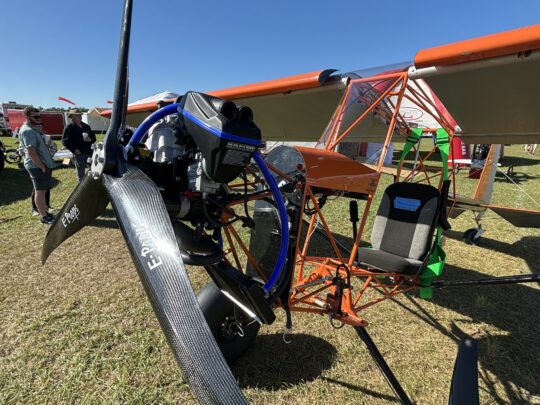
Parallel paths toward increased affordability exist. One is hopeful and one is tangible.
On the hopeful side we have MOSAIC, which promises to increase capability and affordability within the LSA category by expanding Sport Pilot privileges and making a range of aircraft available to pilots limited to those privileges. Moreover, the MOSAIC-style LSAs could get a lot heavier and faster and more capable—including potential use at night and in instrument conditions. Finally, “simplified flight controls” provisions may pave the way for personal aircraft with amazing performance characteristics operated via something like an iPad—rapid implementation of such significant automation with the reliability required to move people is likely an expensive endeavor, but production cost decreases due to economies of scale are possible in the long-term.
But here’s the rub: MOSAIC isn’t real yet and won’t likely be until 2025, perhaps even late in the year. Isn’t there something you could do now, rather than wait? Absolutely—let’s apply some elbow grease, tenacity, and sticktoitiveness:
- Consider buying a reasonably priced used LSA and attending a Repairman course to begin learning the relevant maintenance practices.
- Become a Sport Pilot Instructor with 100 less hours than a traditional CFI, realizing the opportunity to begin flying for an income at 150 hours, lowering the cost to enter the profession and motivating more flight schools to purchase LSAs, reducing training and acquisition costs across the fleet.
- Develop great relationships with mechanics and wield the privileges afforded to you by Part 43, Appendix A, leading to a much more financially fulfilling love affair with Part 23 certified aircraft.
- Support organizations like EAA, that advocate for big wins like VARMA, which reduces parts replacement costs, and, if proven effective on older types, may lead to utilization in later models.
- Show up to have coffee with the old guard at your local airport and connect with someone that has an airplane but doesn’t fly it for various reasons—maybe they’re interested in cost sharing.
- Involve yourself with the local flying club, whether they have a sleek, sexy, nicely equipped LSA, or a ratty (but mechanically sound) Skyhawk.
- Advocate through your preferred organizations for careful and thoughtful revisions to strengthen the liability protections afforded to manufacturers and maintainers.

- Individual development efforts associated with growing your ability to contribute to operational and maintenance cost management, notwithstanding your preferred aircraft certification category.
- Volunteerism and financial contributions to general aviation advocacy organizations and an informed awareness of the work being done on your behalf by those entities.
- Meaningful revisions to the liability protections afforded to manufacturers and maintainers who make aviation possible when the NTSB rules something along the lines of “the pilot’s failure to …” in order to maintain an environment of business agility in both the LSA and Part 23 aircraft arenas.
It seems like a tired trope to say “put in some effort,” but that, in conjunction with what MOSAIC hopes to accomplish, inspires in me loads of optimism about future affordability within general aviation.
My concern with leaning too far in the direction of a regulatory cure is our history of reliance on failed regulatory cures, so we must contribute to the outcome, not simply sit waiting for an external solution—all while believing that those folks working so hard to support us with regulation are gonna knock it outta the park.



Really tired of the trope that LSA weren’t as affordable as expected. Adjusting for inflation, you absolutely can get an LSA that will knock the socks off a Piper Cub on just about every dimension, for the prices that were originally expected (or pretty close to it).
Two unexpected things happened along the way, though. One, was that people wanted to use LSA as reliable transportation because conventional non-LSA planes are so incredibly expensive now. That meant getting speeds right at the LSA limit, maximizing the heck out of useful loads, and cramming the instrumentation of an airliner in there. All of that proved to be expensive. A fully-loaded Bristell is a heck of a machine – but it’s pricey.
The other thing that happened was that the expected demand at that originally promised, low-ish price point simply never showed up. There just aren’t very many people who want simple, slow, lightweight airplanes for the cost of a really. nice car. We thought there were; there aren’t.
But if you do want an affordable LSA, you can absolutely have one, as promised.
Even in DIY Ultralight Aircraft, the cost of materials is a very limiting factor. Add an engine that is likely to cost more than a used car, or truck.
Aviation is no-longer a sport for the average person.
No question, it takes a lot more dollars today to buy aviation in 2024. However, you have choices that are quite “affordable,” with that term in quotes because it is different for every person. I maintain that most pilots can still buy an aircraft but they may need to keep an open mind about the type, its equipment, and how new it is.
As I look at buying an airplane I keep painfully realizing that the airplane itself is the cheap side of the equation. Hangar expenses at any airport within 2h of me is $650/month for the cheapest and smallest T hangar, going up in price quickly from there. Simple/safely folding wing designs and simple trailer storage would be a huge asset to affordable aviation.